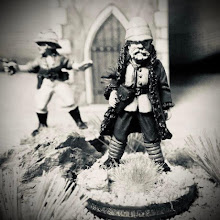"Why does the artillery have to take up so much space? I just want to be able to maneuver around!"
There is always a fine line between realism, playability, and price (money we spend in our hobby!). As a retired officer and military historian, I do realize the space field artillery takes up in real life - especially in the horse and musket era. Most rules make a compromise; one of the better I have seen is illustrated in the above photo of 15mm ACW artillery for the game Fire and Fury which has one gun and one limber represent a battery. My favorite set of English Civil War rules is Victory without Quarter which has one gun on a big honking base to represent an artillery battery.
During a family event I had the opportunity to revisit Chickamauga National Battlefield. (Don't you hate it when a family event takes you near a battlefield?) The Battle of Chickamauga was the only significant victory for the Confederacy during the American Civil War and the result was thoroughly wasted. While in the Visitor Center I came across some excellent models of the horses, wagons, teams, etc., that you would see in an artillery battery during the ACW.
By 1863, most Union batteries consisted of 6 guns, not all of which would be the same; sometimes 4 of one type and 2 of another for tactical flexibility and commanded by a captain. By 1864, it was not unusual for Union Army batteries to be reduced to four guns, due to shortage of available horses. Confederate batteries were usually 4 guns at this time and may or may not follow the Union organization of gun flexibility.
On with the pictures:
Horses were required to pull the enormous weight of the cannon and ammunition (close to two tons for a cannon and its attached limber chest of ammunition). On average, each horse pulled about 700 pounds (317.5 kg).
Each gun in a battery used two six-horse teams: one team pulled a limber that towed the gun, the other team pulled the limber that towed a caisson. The limber was a two-wheeled carriage that carried an ammunition chest. It was connected directly behind the team of six horses and towed either a gun or a caisson. In either case, the combination provided the equivalent of a four-wheeled vehicle, which distributed the load over two axles but was easier to maneuver on rough terrain than a four-wheeled wagon.











Neil -
ReplyDeleteThe realistic (verisimilitudinous) handling of war games artillery has been a topic I have often contemplated. In his Airfix book on the ACW, Terry Wise stated that a 4-gun (CSA) battery deployed occupied 55 yards of front; a 6-gun (USA) battery 82. Now, I gather a certain amount of flexibility was permitted a battery's deployment, but I took those numbers as more or less standard.
Interesting numbers, which suggests artillery frontages as 27 yards per section, plus one extra yard for the total formation. Why that extra yard I can't fathom. That seems to be the pattern at any rate. In developing my 'big battles' Napoleonics game, I tried to make my triangular or trapezoidal bases represent those frontages, with the number of guns represented by the number of crew figures.
Incidentally, I read somewhere that Napoleon I thought 4 guns the ideal battery size, but any project he had in mind to effect the change foundered upon the lack of equipages to supply the extra numbers of batteries. So he was stuck with his 6- and 8- gun units.
Cheers,
Ion
Some great comments. I remember in the Rules for Napoleonic’s by Bruce Quarrie that I thought the frontages were too big for artillery and cavalry as a teenager. Now I know better! Often it comes down to playability vs. realism for the player.
DeleteNeil
VnB is one of the few sets that addresses the amount of room formations take up, especially in road column.
ReplyDeleteNeil
That it does and one of my favorite rules. I emphasize when I read about logjams on the roads!
DeleteNeil
Neil, this is a very informative post and visual representation of ACW artillery in action. Thank you!
ReplyDeleteThanks Jonathan.
DeleteNeil
Most certainly the logistical requirements of artillery, especially from the Napoleonic period onward is overlooked in far too many tabletop simulations.
ReplyDeleteExcellent little article Neil.
Thanks and great comments. I forgot who said it but it was drilled into me: Amateurs study tactics and professionals study logistics.
DeleteNeil
Very useful info Neil, many thanks, Simon
ReplyDeleteThanks!
Delete